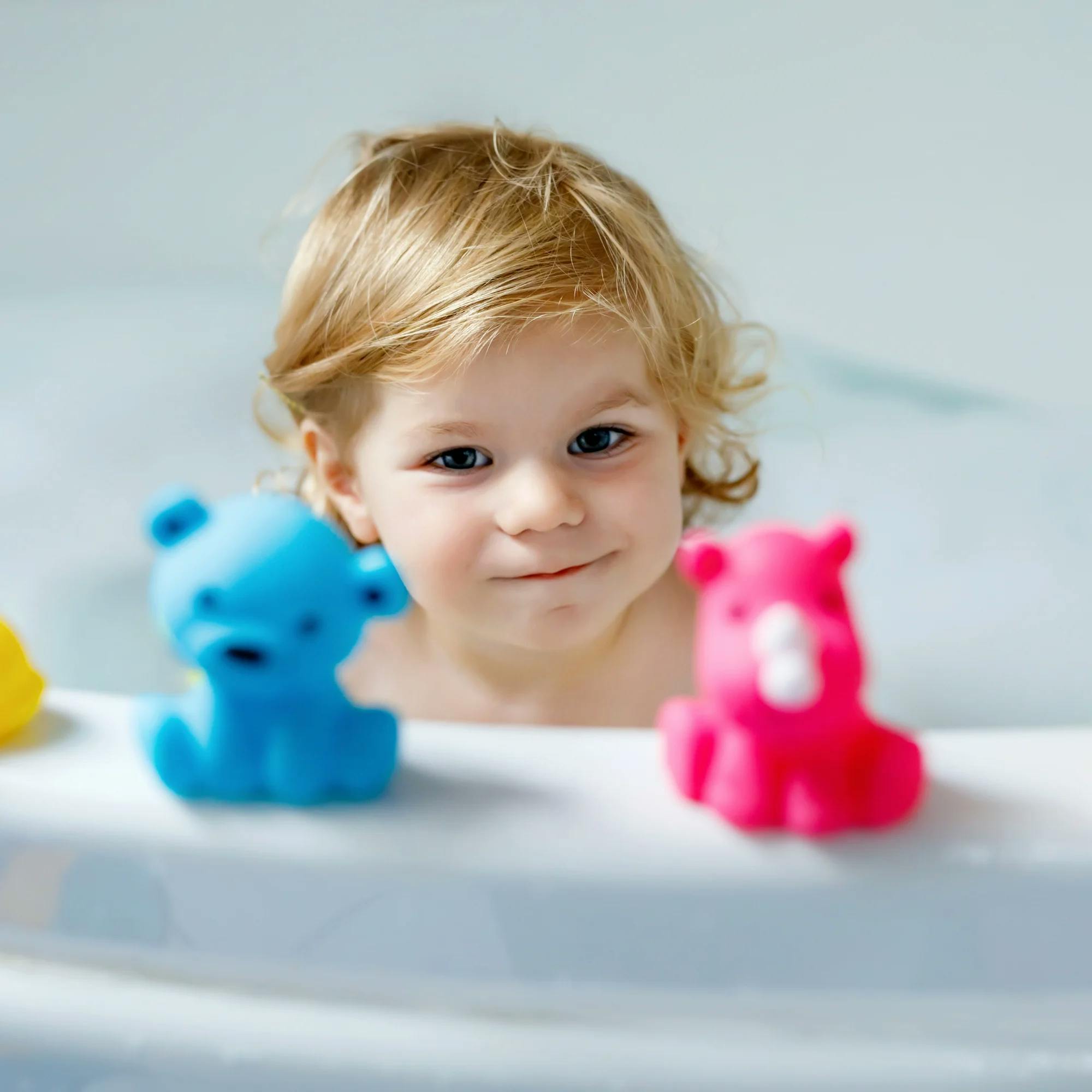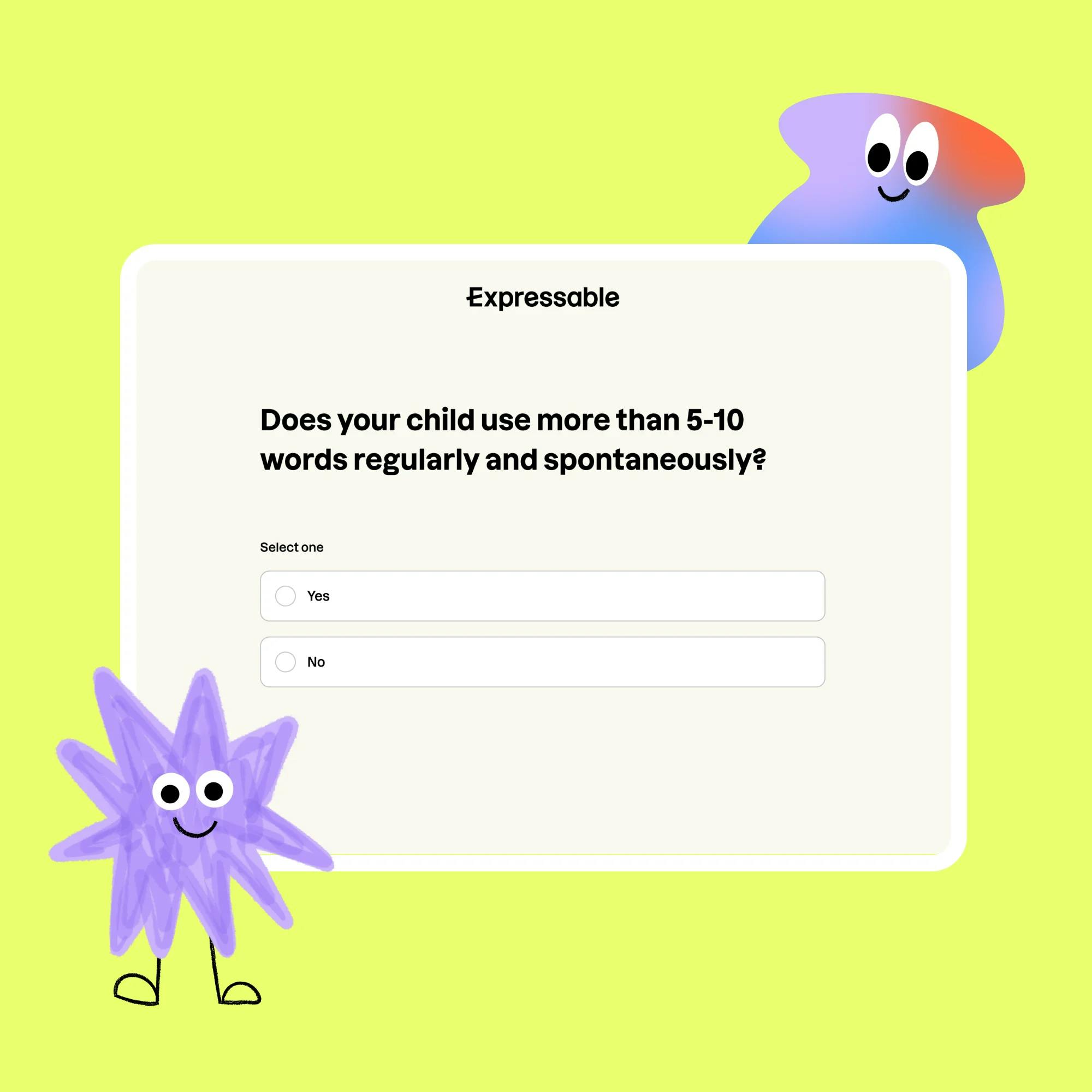
Help Your Child Learn Language Skills with Labeling and Requesting
 Abby Barnes, M.S., CCC-SLP
Abby Barnes, M.S., CCC-SLP
There’s no doubt, hearing your child say their first word is an exciting moment. But the speech milestones don’t stop there. Once a child begins using words, they can then start using those words for different functions.
Early talkers will typically begin by naming, or labeling, items. If they see a dog, or their bottle, or a ball, they say the item’s name for the purpose of labeling it. But over time, children will use these same words for the purpose of requesting. Your child may ask, “Bottle?” when the bottle isn’t even in sight, simply because they’re hungry.
This is a sure sign of growing language abilities! And as your child’s caregiver, you can play a big role in helping them continue to use words for different purposes. Here are some easy ways to do just that.


Modeling language to help your child talk
Let’s start with the basics: Modeling language. This is a simple technique you can begin early on. Best of all, it’s easy to incorporate into your everyday activities.
When your baby is about 2 to 3 months old, you’ll notice their eyes become full of curiosity. They’ll begin to observe and take interest in their surroundings. Even if your baby is a bit older than 3 months, watch them to see when they become intrigued by something. This is the perfect opportunity to begin teaching your baby the names of items!
Research shows that the number of words a 6-month-old baby understands is related to how often they hear words in their daily lives.
Here’s how to do it. When you see that your baby is interested in something, listen for any communication from them, such as a coo or babble. Then, label what they would have said in that moment if they could talk. If your child looks at their plate and squeals or says “baaa,” you could say, “Banana! Yes, it’s a banana. Yummy banana!”
Research has shown that the number of words a 6-month-old baby understands is related to how often they hear words in their daily lives. So even though your baby can’t answer you yet, take every opportunity to speak to them and model language. This will help them develop an entire bank of vocabulary words. And you can do it anywhere, teaching your child the names of items as you play together, get dressed, run errands, visit the park, and even while reading books!

How to teach your child to name things
The skill of labeling is an important one, since a child’s first words are usually labels. Babies will name and label people and things they love and are familiar with. So the more names of items they know (learned through your modeling!), the more likely they’ll begin labeling once it’s time.
This typically happens near a child’s first birthday or a couple months after. So be on the lookout around this time for the first words to appear! To help your child start talking, you can practice labeling with them.
Earlier, we talked about doing this when you notice that your baby is interested in something. As your kiddo gets a bit older, you don’t necessarily have to wait until they're captivated by something to practice labeling. You can direct their attention to an item you want to label.
Imagine you’re out on a walk with your child. If you see a dog, point to it and label it a few times, like this: “Dog, dog. The dog is walking.”
Here’s another example: When you’re getting your child dressed for the day, label their clothing items. You might say, “Shoes! Here are your shoes.” Make sure your child is watching and paying attention.
Repeat words often to help your toddler talk
It probably won’t surprise you when I say that repetition is key. You need to repeat the words frequently to help your child learn them. While you may feel a bit like a broken record, I promise, it’s making a big difference in your child’s language development!
Wondering how well your child is learning all these new words? Try asking them to identify an item. For example:
Next time you’re on a walk, you can ask, “Where is the dog?”
Or, say you’re reading a book about cars and trains. Ask your child to point to the train on the page.
As your child uses items in their daily tasks–playing with different toys, brushing their teeth, putting on a shirt–ask them, “What’s this?” or “What do you see?”
Just a few minutes a day of practice like this can give you great insight into all the words your child is learning!


How to teach your toddler to ask for something
Labeling is a huge milestone, and certainly one to celebrate! But remember, language development doesn’t stop at naming things. Eventually, children take their labeling skills to the next level, learning to use their new words for the purpose of requesting.
Think about it like this: A child may easily label their favorite teddy bear as “bear.” But using the word “bear” to ask that you give them the toy is an entirely different use of that word.
If your child has begun labeling, start watching for them to shift their focus from labeling items to requesting items.
Curious or concerned?
Our free screener is tailored by age and covers all areas of speech, language, and feeding. Find out if your child might need speech therapy.
 Screener for children
Screener for childrenLet’s discuss how to put this into practice at home! First, think about things that are motivating for your kiddo. This might be a favorite snack, toy, or book. Then, watch for opportunities to naturally prompt your child to request.
For example, if your child is reaching or pointing to something they want, ask them, “What do you want?” Make sure to wait a few seconds to see if your child will respond with a verbal request, such as “Please,” or “I want,” or “Give me.”
In the beginning, if your child isn’t responding, give them a little hint, such as the sound the word starts with. So if you know your child wants the bear, you would say, “What do you want?” and wait for them to reply. If they don’t respond, you could say, “B-b-b-b-bear?”
Over time, your child will likely respond more independently, relying on you less and less for hints or modeling. Chances are, you’ll have a little talker on your hands requesting items right and left. Once kids realize the power their words have, there’s no stopping them!


What to do if your child isn't using words to label and request
Keep in mind that labeling and requesting are big accomplishments! They may seem simple to us, but to your child, this is a whole new world of communication. It may take a lot of time and practice from each of you. The more you practice with your little one, the more natural these types of interactions will become.
If your child has reached their first birthday and they’re not labeling items with simple words, continue working on it, but keep a close eye on their progress. Twelve months old is the ideal age to see children beginning to label. If your child turns 14 months old and is not yet labeling, it’s a good idea to talk with your pediatrician or a licensed speech-language pathologist.
If your child isn’t asking for items with simple words by 15 to 16 months, talk with your pediatrician or a speech therapist.
In terms of requesting, if your child isn’t asking for items with simple words by 15 to 16 months, this is also a good time to speak with your pediatrician or a speech-language pathologist.
It’s likely that these professionals will recommend a speech and language evaluation. The results of the evaluation can give you an idea of how your child is progressing in their development. You’ll also learn if speech therapy may be necessary.


Speech therapy is the very best tool you can give a child who is behind in their language development. With speech and language, it’s common for children to need extra help meeting crucial milestones expected for their age. That’s why it’s so important for caregivers to know how to spot the early signs of delays.
The earlier a child starts speech therapy, the more quickly they can make progress. Early intervention can also decrease the severity of their speech delay over time.
I hope this information helps you feel equipped and ready to help your child grow their language skills. Although it may feel like work at times, the practice and attention you give to your child’s development is worth it. Everyone deserves the chance to express themselves and communicate clearly. What’s a better gift to give your child than that?
How Expressable Can Help
Concerned your child isn't reaching age-expected milestones? Looking for communication support from a professional? Expressable is a national online speech therapy practice serving children and adults. We treat all major areas of communication and feeding, offer flexible hours including evenings and weekends, and accept most major health insurance plans. We’re proud to have earned more than 3,000 5-star reviews from our clients (4.9/5 average).
Our therapy model is centered on parent and caregiver involvement. Research proves that empowering caregivers to participate in their loved one’s therapy leads to better outcomes. That’s why we combine live, 1-on-1 speech therapy with personalized education and home practice activities for faster progress.
Communication is more than words. It’s how we share how we feel and show who we are. We’re here to help you or your child do just that.














